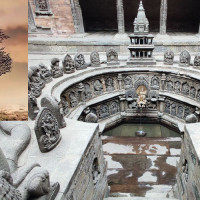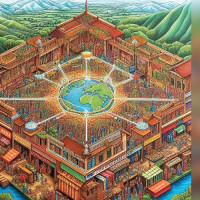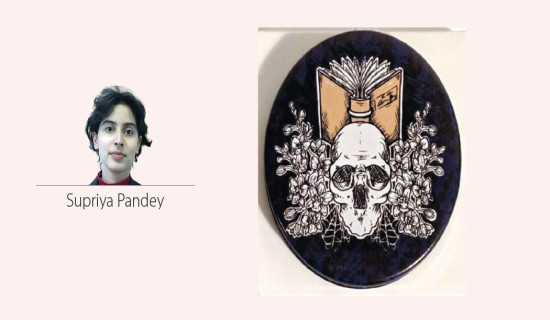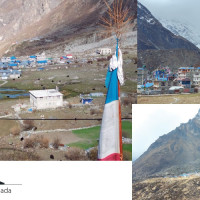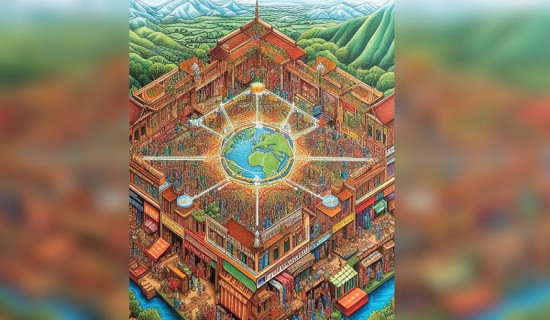- Friday, 20 June 2025
Swa: Journey Within The Self
Swa, a novel by Pratikshya Saraswati, invites the readers on a transformative journey into the realms of enlightenment, spirituality, and the essences of the self.
The novel examines the pursuit of inner peace, contrasting material prosperity with spiritual enlightenment. The narrative centres on the concept of self, integrating elements of Buddhist philosophy and the process of self-realisation. The novel contrasts the simplicity inherent in spiritual life with the complexities of worldly attachments.
Pratikshya deliberately emphasises spiritual enlightenment in the self, focusing on the inner self. If we are not content and satisfied, we can easily break from within at any phase of our lives.
We remember the trauma and suffering as a reflection of our mental state. So if, in our heart, we want happiness, progress, and contemplation, we need to free ourselves from the material object and take a deep breath on a journey of self-realisation. Admiring a spiritual thought to shape a new journey is essential, as life is complicated. But the foremost thing we must adore, admire, and love is our pure inner self.
Saptma and Kavya are the central characters. Both are different, and it is as if they were a dichotomy. Saptma has had all kinds of painful experiences and an abundance of disappointments within himself. A hard-working, dedicated person desires to achieve the whole world from morning till late night. Soon after leaving campus as a professor, he's always contemplating participating in side jobs as a lawyer, wakes up a broker, and is exhausted. As time flies rapidly, there is no rest for the whole body of a work-centre person.
On the other hand, Kavya, a soft-hearted girl, admired small things with loyalty. Passionate and satisfied within a single profession only as a lecturer, her strength has been to work less and be alive. Extremely attached to Mom and always prepared to harmonise in an actual relationship is the charisma of her beauty. Yet both of them continuously admire each other's company as spiritual lovers, and they are ready to illustrate their drawbacks and strengths, too. Fighting over small things without cause, travelling together, love for poetry, and nature enchantment are their core time and love. Having a traumatic childhood memory and the absence of parents' love made Saptma a different person he is unconscious of. In the absence of a peaceful time, never being happy and unsatisfied with oneself is the result of acquiring extra wealth. Imbalance in his nature and behaviour are the consequences of hard times that entangle with different threads of life he has gone through. While running towards money time, he was fortunate to have a true friend and lover, Kavya, whose natural insight focuses on satisfaction and peace of mind, giving him everything as a soothing ointment.
The novel's power is enlarged after the second part, accustomed to strange places and people. All the characters are appealing with such a charismatic aura that the person is the heart's centre and expresses his/her lines like the burning fire. Most of the leading characters lost their lives, but they still exist despite suffering, pain, and stress above the path of love and forgiveness. Another captivating character, Siddharth, is very close to the protagonist, as his mother passed the same stage and had the same upbringing. Yet the boy has no trace of frustration or misery on his face for cutting his father's hands. The love and respect for Mother is never-ending, never faded.
The bitter truth reveals Saptan as he realises that his hatred towards his mother is just because of his ignorance. Neither has he admired the mother's freedom nor her love. He never attempts to appreciate his mother's affection and warmth. As a self-centred child, he only blames the environment but never understands the mother as an independent entity. Loves that thrive from family members are extremely difficult to handle in his early phase of life, commenting on their behaviour and nature, especially from the parents he craves. Being a mother is tough, and at one point, the worry that the struggle between husband and wife changed and affected him badly was at its pinnacle.
However, pure love has nothing to do, even with imperfections. Yet the concern marked the disgust he often felt over the last decade with anxiety and distress. But after joining the spiritual class for seven days, he became conscious that the uppermost pain he held inside was nothing compared to others. Likewise, in our lives, we perceive the things we want only from our point of view rather than other perspectives. After having clear boundaries, the protagonist ensures everyone is bound by his fate and certainty.
The novel emphasises continuous learning and its impact on the holistic persona as an individual's growth and self-awareness. It also enlightens us towards the love for the self and inner soul. Struggles within themselves, conflict within the self, and walking along with daily suffering through the characters, such as in Maidee Kenara ko gau, khashilal, Aadheree, and Sushila , gained everything after their hardship, married life, and boldness celebrated with great joy, yet they are entangled with such low tides which always bound them and are never free.
Happiness is just a small thread of a circular line, as most lose their dearest ones. But still, all of them deliver such a spiritually motivated speech, changing the protagonist's perspectives, along with another persona. Even in pain, the Guru preserves and uplifts another person's life with enlightenment and happiness throughout the journey, which is the main treasure of the novel. Leaving the chaos and making the person calm and peaceful within himself is empowered only thoroughly by a seven-day education programme, enchanting mantras, life-learning ideas, and the class on spirituality and meditation.
The Om mantra is enchanted throughout the sessions, whose reverberation enriches the class and makes it more lively and enchanting. The Guru is of a different age, with an energetic vision, shifting our thinking and ideas. We arose on the pinnacle of spiritual enlightenment, adding charm through the life-learning process. Positive thinking and self-realisation create a new vibration within us through the subsequent phases of life. In the face of life's dilemma, we become conscious that our actions, hard work, and recognition are nothing until and unless we are unified with body, mind, and spirituality.
Life is a teaching and learning process, and connection with the soul makes us realise that whatever accumulates or feels proud is nothing if we are not illuminated with our inner self. Darkness, shadow, confusion, fragments of despair, and tears apart within our inner self when we appreciate, admire, adore, and love ourselves. Self-realisation, or acquaintance with self, is the journey from darkness to light, regardless of where we have come from and what we have become. The purest sheer of the soul emerges only within yourself, the depth of self-realisation.
The novel embraces being true to oneself even with obstacles and fear as a unique feature. Saptan achieved the spiritual enchanted words as soothing medicine in the later phase of his life. After an extended walk, his inner consciousness cheers up with the most productive and energetic time; admiring the company of other philosophical ideas enlightens him as a different person from the preceding one. There is no search or longing for the material world, as he is free from the mundane world.
The core idea of the novel, Swa, self, or self-love, is not a race in participating with others but the journey of acceptance of who we are, appreciating the difference between good and evil, failure and success, an ongoing process.




